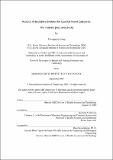| dc.contributor.advisor | Kenneth N. Stevens. | en_US |
| dc.contributor.author | Jung, Youngsook, Ph. D. Massachusetts Institute of Technology | en_US |
| dc.contributor.other | Harvard University--MIT Division of Health Sciences and Technology. | en_US |
| dc.date.accessioned | 2010-04-28T17:12:06Z | |
| dc.date.available | 2010-04-28T17:12:06Z | |
| dc.date.copyright | 2009 | en_US |
| dc.date.issued | 2009 | en_US |
| dc.identifier.uri | http://hdl.handle.net/1721.1/54630 | |
| dc.description | Thesis (Ph. D.)--Harvard-MIT Division of Health Sciences and Technology, 2009. | en_US |
| dc.description | Cataloged from student-submitted PDF version of thesis. | en_US |
| dc.description | Includes bibliographical references (p. 139-142). | en_US |
| dc.description.abstract | In recent years, research in human speech communication suggested that the inventory of sound units that are observed in vowels across languages is strongly influenced by the acoustic properties of the human subglottal system. That is, there is a discrete set of possible vowel features that are constrained by the interaction of the acoustic/articulatory properties of the vowels and a small set of attributes that are observed in the subglottal region. This thesis tests the hypothesis that subglottal resonances govern vowel feature boundaries for three populations: adult speakers of English; adult speakers of Korean; and children learning English. First, we explored the relations among F1 of vowels, the first subglottal resonances (SubF1) and the feature [low] in English. For the diphthong [??], F1 peaks for vowels showed an acoustic irregularity near the speaker' s SubF1. For monophthongs, analysis of F1 frequency distributions shows a boundary between [+low] and [-low] vowels at the speakers' SubF1. Second, we studied the relations among F2 of Korean vowels, SubF2 and the feature [back], to test whether the relation between subglottal resonances and the feature boundary, demonstrated earlier for English, also can be applied to other languages. Results show that the F2 boundary between [back] and [front] vowels was placed near SubF2 in Korean, as in English. Third, we explored the development of vowel formants in relation to subglottal resonances for 10 children in the age range of 2;6-3;9 years using the database of Imbrie (2005). Results show that at the earlier ages, formant values deviated from the expected relations, but during the six month period in which the measurements were made, there was considerable movement toward the expected values. | en_US |
| dc.description.abstract | (cont.)The transition to the expected relations appeared to occur by the age of 3 years for most of these children, in a developmental pattern that was inconsistent with an account in terms of simple anatomical increase. These three sets of observations provide evidence that subglottal resonances play a role in defining vowel feature boundaries, as predicted by Stevens' (1972) hypothesis that contrastive phonological features in human languages have arisen from quantal discontinuities in articulatory-acoustic space. | en_US |
| dc.description.statementofresponsibility | by Youngsook Jung. | en_US |
| dc.format.extent | 142 p. | en_US |
| dc.language.iso | eng | en_US |
| dc.publisher | Massachusetts Institute of Technology | en_US |
| dc.rights | M.I.T. theses are protected by
copyright. They may be viewed from this source for any purpose, but
reproduction or distribution in any format is prohibited without written
permission. See provided URL for inquiries about permission. | en_US |
| dc.rights.uri | http://dspace.mit.edu/handle/1721.1/7582 | en_US |
| dc.subject | Harvard University--MIT Division of Health Sciences and Technology. | en_US |
| dc.title | Acoustic articulatory evidence for quantal vowel categories : the features [low] and [back] | en_US |
| dc.type | Thesis | en_US |
| dc.description.degree | Ph.D. | en_US |
| dc.contributor.department | Harvard University--MIT Division of Health Sciences and Technology | |
| dc.identifier.oclc | 601947486 | en_US |
